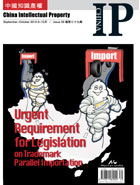The launch of .中国 Top Level Domain (TLD) in 2010 is a milestone in Internet history. On Auguest 25, 2010, a report concerned with China’s domain name service and security status was issued. The report pointed out that China has about a million domain name servers; more than 50% are not safe. According to the statistics published by CNNIC, the amount of .cn users is declining while that of .com is seeing a sharp increase. Mr. Skou shared with us his understanding on current domain name questions raised by China IP.
Q: What are the problems brought with the emergence of .中国 TLD?
A: It is common knowledge that local cultures and traditions play an important role in the interaction between brands and their customers. I personally believe it will take a few years, until the new .中国 will really be the most dominant and searched for TLD. Simply, Chinese netizens are already familiar with and used to entering Latin characters at the first level. Maybe a .中国 key on the keyboard would help accelerate the success of the new TLD. The success of the new .中国 will depend
on a number of factors such as; How will the browsers (such as IE, Firefox, Opera etc.) support .中国? It appears all major browsers are already supporting the new TLD without Netizens having to install specific software or plug-ins. Also, how will the large search engines such as Baidu, Eastnet, Google, Bing, Yahoo! etc. rank the .中国 TLD? If they will give it a higher ranking than .cn or .com, this will support the success of the new TLD. Furthermore, the mobile phone and smart phone producers, as wel l as the key board and laptop producers play a role. If they make it easy to switch between Roman and Chinese characters when browsing the Internet or whensending Emails, the .中国 will profit tremendously from such features. Lastly, the domain name registration policy of CNNIC play a key role in the potential success of .中国. I believe that the current rules to some extent may obstruct the success of the .中国 TLD. The requirements simply make it difficult for private persons as well as for foreign entities to register the new .中国 and this fact may lead to a situation, where Netizens find fewer interesting .中国 websites than websites under other less restricted TLDs such as .com , .net , or .asia .
Q: What are the commonalities and difference in domain protection between China and foreign countries?
A: I n t e r ms o f domain name protection, the domain name dispute resolution policies in China and in most other countries are based on the following common principles:
1. Your domain name is identical or confusingly similar to a trademark or service mark in which the complainant has rights.
2. You have no rights or legitimate interests with respect to the domain name.
3. Your domain name has been registered and is being used in bad faith.
In the administrative proceeding, the omplainant must prove that each of these three elements are present. The main difference between the domain name dispute resolution practices in China and most other Western countries is the Chinese “two-yearrule” for .cn domain name disputes. If a domain name has been registered for more than two years, a complainant cannot go to arbitration, and must take the domain name dispute to court instead. Obviously, many Western brand owners would like the CNNIC to remove this rule, as they often do not discover the infringing domainnames within two years and also, in some cases, need a few months to investigate and prepare the
case before actually filing the complaint to either of the two .cn arbitration centers.
Q: What’s your definition to a “domain strategy”?
A: A domain strategy is an overall plan on how to achieve the 3 strategic goals of the usage of domain names:
1. Visibility (Marketing);
2. Protection of Intellectual Property
Rights (Legal); and
3. Security (IT).
Thus, a B2B machinery component manufacturer would have a need for less domain names, less monitoring and enforcement than a B2C global brand selling and promoting their services Online. Certain industries are facing larger challenges in all three areas: Marketing, Legal, and IT. For instance travel agencies are facing huge competition in terms of search engine rankings and generic domain names related to their industry (i.e. travel.com , gotochina.com), as are banks having to register a number of defensive domain names in order to protect their customers from online fraud attempts.
Likewise, large brands need to protect their .com addresses with additional “typodomains” simply to avoid the risk of losing mistyped emails meant for them and not for the registrant of a “typo domain name.” Typically, a domain name strategy consists of a description of overall goals and responsibilities. A domain name policy document made accessible to all employees on the Intranet of a corporation may very well determine such issues as: Who is in charge of the domain name strategy? In which TLDs do we register domain names? Which variants of spelling (singular/ plural) do we register?
How do we check that we are not ourselves infringing on third party rights? How to activate the domain names? How to monitor for and react upon infringing domain name registrations, websites, social media, blogs etc.
Q: Suppose that “.brand ” TLD is opened, what details need to be concerned for a corporation to protect its online IP and promote its brand publicity?
A: There is no doubt that the ICANN will eventually open the generic top level domain name space to hundreds of new applicants. The question is when. It appears that the most realistic timeline is that the ICANN will seek to settle the remaining open issues related to the new generic top level domain (gTLD) programme this autumn, then launch a new version of the Draft Applicant Guidebook (the regulations for the introduction of new gTLDs) prior to the next ICANN meeting in Columbia, December 2010 and finally publish and approve the final version of the Applicant Guidebook at the ICANN meeting in San Franciso next spring. If that assumption is correct, ICANN will then open the application window in the second or the third quarter of 2011. In other words, we will see the first batch of new gTLDs at the beginning of 2012 and most of them in 2013. As a brand owner, one should analyze, if and how a .brand TLD could benefit the company from a marketing and business development perspective. It will vary a lot from industry to industry and from business strategy to business strategy, whether such a .brand TLD is recommendable. But it is not for everyone. Costs alone – it is estimated the application and launch will initially cost in the neighborhood of USD 400,000 to 1,000,000 and the yearly costs around USD 200,000 plus additional marketing costs and internal resources – will exclude more or less all SMEs and thus .brandswill be an adventure purely for large brand owners. If promoted and used in a smart way, a .brand could be a very good investment for large brands. In the banking industry a safe .brand TLD zone can be established.
It will not be possible to “typosquat” or “cybersquat” under first level domain names, as the registration policy can be restricting the registration only to the brand owner or their affiliates. A more
aggressive usage of a .brand TLD would be to allow customers or fans to register domain names and email adresses under .brand and in this way promote the brand to their friends and piers. Even customer IDs, user names, logins, serial numbers etc. can be constructed under a new .brand TLD and increase the customer service and safety surrounding brand products. In addition to a cost benefit analysis, all large brand owners should make a risk analysis from an IP perspective. What is the risk that somebody else may register a .brand TLD which is identical to or similar to my brand? As opposed to trademarks, where the same name can coexist in different classes, there can only be one string for a top level domain. First come first serve. Obviously there are thorough and efficient Right Protection Mechanisms (RPMs) in place so that anyone can object to the publication of new gTLD applications once they are submitted to ICANN. A brand owner such as Citibank could therefore obstruct an application by a third party applying for .Citi provided, of course, this party has no legitimate right to .Citi . For many brand owners the sharing of thei r brand names wi th other companies is a real problem. For instance, who gets .polo ? Is it Ralph Lauren? Or Volkswagen? In case of multiple applications for the same string (.brand or .city or .genericterm ), provided all applicants fulfill the application requirements, the applicants may end up in an auction based bidding process. These bids may turn out to be very expensive. Another risk is that a visually confusingly similar textstring is granted in the first application round. These are some of the issues a brand owner has to analyze at this stage. Related to these issues are such issues as choice of technical set up, allocation of internal resources, project planning, etc. IP

Jannik Skou have worked with a number of
Fortune 500 and Europe Top 500 companies in
the areas of domain name strategy, domain name
management, brand protection, investigation,
domain name audits and business process
optimization.





